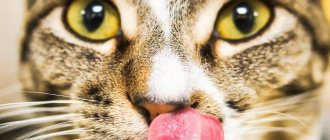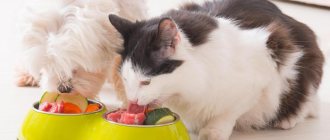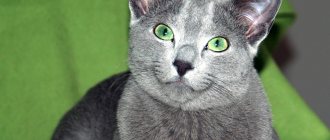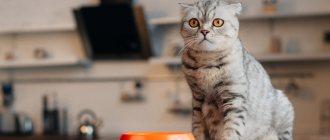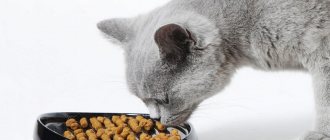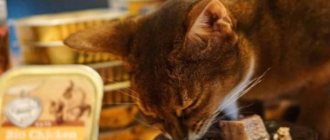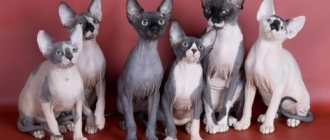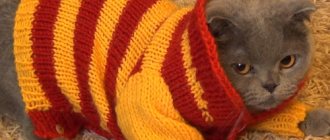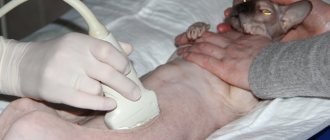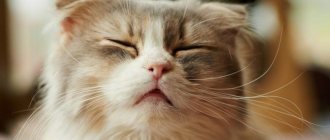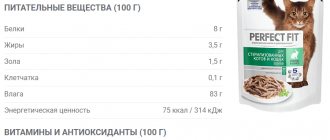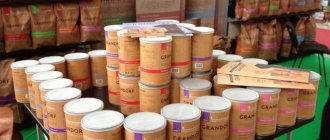Feeding cats with natural food is as close as possible to the conditions of the wild. Despite this, such a diet has its disadvantages and nuances. Before feeding your animal regular foods, be sure to familiarize yourself with possible problems and features. This will help you weigh the pros and cons between dry food and natural food.
Why owners choose natural feeding
Most owners refuse dry food, choosing a more natural way of feeding. Citing the advantages of a “straight woman” as an example, they often forget about her shortcomings.
Advantages
The main advantage is the ability to independently control the quality of ingredients. This eliminates the presence of harmful chemicals and artificial components.
With this type of nutrition, it is easier to choose an individual diet, based on the characteristics and preferences of your pet. It is much easier to accustom to “natural” than to “drying”. Cats are carnivores, so they happily eat meat and offal.
Possible disadvantages
Natural food for cats should always be fresh, which means it will have to be prepared every day. This takes a lot of time and effort, so not all owners are ready for such sacrifices.
In addition to the laboriousness of preparation, it is worth noting the difficulty of achieving a balance of KBJU (calories, proteins, fats and carbohydrates) and the mandatory inclusion of vitamin and mineral supplements. There is also a high probability of helminth infection or poisoning associated with improper storage or preparation of products.
Food
Like many people, cats love to eat good food and snack between meals. Cat snacks are probably healthier than most of our “junk foods.” However, if there is a problem of overeating, or overfeeding, then the pet's health can seriously deteriorate.
When it comes to healthy eating, there are three main types of cat food including:
Fresh or frozen food
In the mid-20th century, studies were conducted that confirmed the benefits of raw foods for cats.
Canned food
Canned food is the next best choice for cats after fresh.
Dry food
In today's society, when people are away from work for a long time, raw or canned food can spoil, so dry food is used.
Main components of the diet
A natural diet for cats consists of proteins, fats and carbohydrates. Their percentage ratio should ideally be 52:36:12.
Proteins: meat and dairy products
Proteins are used in the construction of new cells and act as the main source of energy. All of them are divided into 2 large groups:
- Animals
. Contained in meat (chicken, turkey, beef, rabbit, lamb), offal (liver, lung, heart), fish, eggs and fermented milk products (cottage cheese, kefir, yogurt). Chicken protein is the easiest to digest, and the worst is beef and lamb protein. Such proteins contain many amino acids and taurine, an essential element responsible for cell protection and regeneration.
- Vegetable
. Contained in soybean meal, corn gluten and wheat. They are less digestible than animal proteins and put a strain on the kidneys, which leads to alkalinization of the urine. Can be used in small quantities as a temporary alternative to more expensive animal proteins.
When feeding, it is necessary to use well-frozen raw and boiled meat or sea fish, cleaned of bones. Fish can be given no more than 1-2 times a week, since the thiaminase it contains destroys vitamin B. Eggs should be given according to the same scheme.
Fermented milk products cannot serve as the main dish, so they are used as an additive.
Where are fats found?
Fats are responsible for energy “in reserve.” They are also responsible for the absorption of fat-soluble vitamins and the synthesis of certain hormones. The most beneficial fatty acid is Omega-6, found in fish. This element can also be obtained from corn, pumpkin or flaxseed.
Remember to maintain balance. A lack of fat can affect the quality of skin and coat, and an excess can lead to pancreatitis and intestinal upset.
Carbohydrates: cereals and vegetables
Carbohydrates make up the smallest portion of a cat's natural diet, as they take much more time and effort to digest. In the wild, these elements enter the cat's stomach in a semi-digested form through a captured rodent.
Despite this, a small amount of carbohydrates is simply necessary for mustachioed pets. Of these, the following elements enter the body:
- fiber, which normalizes stool and facilitates hair removal;
- adhesive substance that prevents constipation;
- glucose, which supports the functioning of the kidneys, brain and other vital organs;
- prebiotics that normalize intestinal microflora and facilitate the absorption of food.
Carbohydrates come from raw, boiled or steamed vegetables (broccoli, zucchini, pumpkin) and fruits (apples). Complex carbohydrates include oatmeal, buckwheat, rice and egg.
Vitamins and microelements
Unlike “drying”, “natural” for cats should be supplemented with vitamin and mineral complexes. The most important elements include:
- manganese;
- iodine;
- calcium;
- potassium;
- iron;
- taurine;
- phosphorus;
- potassium;
- omega 3 and 6;
- B vitamins and ascorbic acid.
It is better to discuss the choice of drug with your veterinarian, since the dosage is calculated individually. Additionally, you can add sprouted oats and brewer's yeast to your food.
A lack of vitamins is accompanied by deterioration in coat quality, loss of body weight, loss of activity and frequent colds. Excess is no less dangerous, so never buy drugs on the advice of friends.
How many times a day and at what time should you feed your pet?
In nature, a cat only catches small prey. In addition, her stomach volume is small. Therefore, she usually eats in small portions, but often: up to 20 times a day. This doesn't mean you have to keep adding food to the bowl. Hunting takes a lot of energy and requires significant activity. A pet spends less energy, and easily accessible food leads to overeating. An overweight cat seems cute and funny, but excess weight causes health problems. Metabolic disorders, shortness of breath, decreased activity - all this can affect the duration and quality of life.
Calculate the volume of the daily portion and replenish the food supply in the bowl gradually. It is best to do this 2-3 times a day at the same time. General recommendations for feeding regimen and serving size can be found on the cat food package.
Take into account the characteristics of physique and temperament: large and active animals will need more food. You can determine whether you are feeding your cat correctly by its appearance and behavior. Activity, a cheerful appearance, and a beautiful, shiny coat indicate the health of the animal and a well-chosen diet.
Take care of the feeding area as well. Cats are loners and it is important for them to eat in a calm, private environment. Place bowls of food and water in a secluded area. Do not disturb your pet when he is drinking or eating.
Features of cat digestion
The cat's digestive system is very sensitive, and small changes in diet can cause problems. Kittens adopt eating habits from their mother and stick to them throughout their lives, so the pet does not need a lot of variety in food. It is enough to combine wet and dry food of the same brand with several flavors.
An adult cat has 30 teeth: 16 on the upper jaw and 14 on the lower jaw. The fangs are well developed and designed for catching prey, but cat teeth are poorly suited for chewing food. Therefore, the animal swallows food that is chopped into small pieces. Cats' saliva contains large amounts of mucus, which allows them to eat dry food. The animal drinks in small portions: the ancestors of domestic cats were inhabitants of arid places.
A rough tongue helps a cat groom its fur. When licking, the hard keratin fibers on its surface “comb” and smooth the fur. In this case, the animal inevitably swallows a certain amount of hair, and this is not scary. The cat's body has adapted to get rid of them: periodically the cat regurgitates the swallowed fur.
The environment in the stomach of cats is very aggressive. This allows wild cats to digest the carcasses of captured rodents and birds and disinfect their food. But the animal’s body gets used to the constant concentration and amount of gastric juice. A “habit” is formed by the age of 8–10 months, so unfamiliar foods often lead to digestive disorders. In nature, cats periodically eat the intestines of their prey, replenishing the supply of beneficial microorganisms. At home, special foods or specially designed probiotics are suitable to replenish microflora. For example, PRO PLAN® NUTRISAVOUR® DELICATE FOR ADULT CATS WITH SENSITIVE DIGESTION, WITH OCEAN FISH IN SAUCE with the prebiotic inulin necessary for the animal. Or the probiotic feed additive FortiFlora®, which helps normalize loose stools, the growth of beneficial bacteria, and also strengthens the immune system.
Proper nutrition:
- Balanced and satisfies all the needs of the animal;
- Well tolerated and does not cause digestive problems;
- Consistently: It is best to give your pet the same food every day.
What foods should not be given to a cat?
Before feeding your cat natural food, read the list of prohibited foods. These include:
- millet, pearl barley, semolina and corn cereals;
- river fish and any bones;
- potatoes and mushrooms;
- legumes and white cabbage;
- onions, sorrel and garlic;
- pork and lard;
- grapes and raisins.
Milk is only beneficial for kittens, since the body of adult animals does not digest lactose. It is also worth excluding any handouts from the table: flour, spices, pickles, smoked foods, sweets, fatty and fried foods.
Calculation of the daily portion of natural drinks
On average, the daily portion for an adult cat is 5% of body weight. For simplicity, you can limit yourself to this indicator, but it is more reliable to take into account the characteristics of your pet and calculate not the number of grams, but the total calorie content.
For this purpose, it is recommended to use the following formula:
K*(30*m + 70), where K is the multiplier coefficient, and m is the weight of the animal.
The coefficient values can be found in the table below.
| Physiological features | K |
| Lactation period | 2-4 |
| Pregnancy | 1,6-2 |
| Adult and active animal | 1,6 |
| Adult animal with low activity | 1,4 |
| Kitten or adult animal with low weight | 1,2-1,4 |
| Presence of castration or sterilization | 1,2 |
| Elderly age | 1,1 |
| Frequent overeating, fraught with rapid obesity | 1 |
| Physician-confirmed obesity | 0,8 |
If your cat is carrying kittens and weighs 4.5 kg, then she will need 328-410 kcal per day. To get the serving size, the indicated number of calories must be divided by 2, since adults eat twice a day.
Water
Fresh water is the basis of life on our planet. Cats love cool, running water and often drink it straight from the tap. Some cats even play in the water, especially breeds like the Turkish Van. There is nothing wrong with this, and if your cat loves to splash around in the bathtub, you can throw toys into the water to keep your cat entertained.
How much water does a cat need?
About 67% of a cat's body is water. Dry food contains a minimal amount of water, only about 10%, and cats that eat it regularly definitely need a lot of extra water to maintain proper fluid balance in their bodies. Closely monitor the amount of water your cat consumes, as excessive thirst is a symptom of feline diabetes, feline hyperthyroidism, or chronic renal failure. Make sure there is always clean water in your pet's bowl.
Important Rules
Feeding your cat natural products should be safe. Be careful when purchasing meat to avoid the presence of hormones and parasites.
Maintain regular feedings. This will help wean you off begging and eliminate prolonged feelings of hunger. Kittens up to 3 months are fed at least 6 times a day, gradually reducing the frequency to 2 times a day by 1 year.
Serve food in the same area and be sure to use different bowls if you have multiple pets. This will eliminate fights with subsequent overeating in the strongest pet. Remember that food should be at room temperature, and leftovers should be thrown away or refrigerated for several hours.
Natural homemade food recipes for furry pets
Dishes for your cat can be not only healthy, but also varied. You can prepare your pet’s main meal, desserts and various pleasant treats yourself.
Many dishes prepared in this way can be poured into containers or placed in special bags and frozen. This way you will save yourself from lengthy cooking and provide your cat with a supply of food for a long time.
Recipes for preparing healthy dishes:
- Nutritious pate. Boil 0.5 kg of any meat for half an hour, then remove from the pan and add carrots and broccoli to the resulting broth. They must be cooked until half cooked. Pour boiling water over one glass of rolled oats and leave for 15 minutes, then pour out the water. Mix the meat with vegetables and oatmeal in a blender until it becomes a soft paste, add broth if necessary.
- Chicken gizzards with buckwheat. Pour half a glass of buckwheat porridge with water for a day. Boil chicken gizzards and one large carrot, then grind them in a meat grinder or using a blender. Add a small piece of butter to the porridge, pour in the gizzard and carrot pate.
- Millet porridge with turkey and vegetables. Boil small beets and carrots, peel and finely chop the raw zucchini. Divide the turkey into small pieces and cook millet porridge. Grind the vegetables together with the meat in a meat grinder, then add to the porridge. If necessary, you can dilute the dish by adding egg yolk.
- Lamb fillet with rice porridge. Grate freshly frozen lamb meat along with raw carrots. Boil the broccoli and rice in advance, then mix all the ingredients in a bowl with a small amount of olive oil.
- Beef with vegetable stew. Cut the boiled beef into small pieces, mix with baked pumpkin, stewed carrots and zucchini, pour in meat broth.
My cat really loves stewed liver: this dish ranks almost first among her taste preferences. The recipe is quite simple. Cut the liver into small pieces, grate the carrots, chop the green onions. Pour some water into a small frying pan, add all the ingredients and simmer for 20-25 minutes. It turns out to be a quite tasty and nutritious dish that can be mixed with any porridge.
How to prepare a healthy and tasty treat for your furry baby:
- Beef patties. On a fine grater, grate frozen beef (about 200 g), one large carrot, 3 lettuce leaves and 30 g of celery. Add 2-5 drops of olive oil and stir, then beat one egg into the mixture. Yandex Form thin flat cakes, place them on baking paper and bake at a temperature of about 140 degrees until they become golden brown.
- Curd balls. Take thick cottage cheese with 1-2% fat content, mix it with a few tablespoons of sour cream. Form small balls and place them in the refrigerator for a couple of hours to set.
- Chicken with cheese. Peel the skin from the chicken breast, then cut into small pieces. Place it in the oven at 150 degrees, grating no more than 1 tablespoon of hard, lightly salted cheese on top.
Approximate diet for 4 days
Before going to the store, think through your diet for the week ahead, based on the permitted products. For an example, check out the menu for an adult pet for 4 days.
| Day | 1st meal | 2nd meal |
| First | Cottage cheese with raw quail egg | Boiled cod with vegetables |
| Second | Minced chicken with vegetables, seasoned with vegetable oil | Chicken fillet with buckwheat and carrots |
| Third | Boiled beef with zucchini | Boiled chicken liver with oatmeal and herbs |
| Fourth | Broccoli puree with cottage cheese, seasoned with kefir and vegetable oil. | Chicken hearts with cottage cheese |
When selecting a menu, do not forget to take into account the KBZHU in order to eliminate the shortage of necessary elements. Pay special attention to animals with special needs.
Feeding cats with special needs
A separate category includes pets, marked in the table with the calculation of the coefficient for determining the daily calorie content. In addition to the number of calories, when planning their menu you will have to take into account several more important nuances.
Pregnant and lactating females
During pregnancy and lactation, females provide food not only for themselves, but also for their kittens. For this reason, during these periods, calorie content is increased by 1.5-2 times. Due to changes in the amount of food, the feeding frequency is increased to 5-6 times. This makes it easier to digest.
The pet should be fed with chicken egg whites and vegetable oil should be added to its food. This will help avoid too much protein consumption during lactation and prevent constipation.
Kittens
For the first 4-8 weeks, kittens need enough mother's milk. After this time, you can introduce the first complementary foods, consisting of:
- meat broth and minced meat;
- vegetable puree;
- boiled yolk;
- slimy rice porridge and semolina;
- low-fat cottage cheese, kefir and yogurt.
Unlike adults, most of a kitten's food should consist of carbohydrates. For bone growth, make sure you have enough calcium.
Elderly individuals
With age, metabolic processes slow down. An older cat needs much less food than a young cat. Additionally, dental problems develop. During this period, you should use soft and easily digestible foods, increasing the number of meals to reduce the load on the stomach.
Allergy sufferers
If you suspect an allergy, you need to find the allergen. To do this, use an elimination diet, which involves the gradual elimination of staple foods. First of all, it is recommended to remove chicken and egg whites, as they often cause allergic reactions.
With chronic diseases
For chronic urolithiasis, it is recommended to reduce proteins, abandoning plant-based ones in favor of animal ones. Chicken, turkey and rabbit put much less strain on the kidneys and liver, so they are more preferable.
Another useful recommendation for sick pets is split meals. Frequent, but small portions reduce the load on the damaged organ and facilitate the digestion process. It is better to find out the exact menu from your veterinarian, as it is always selected individually.
Spayed and neutered animals
Sterilization and castration slow down metabolism, causing a tendency towards obesity. After surgery, you need to use more fiber to create a feeling of fullness with a small amount of calories. You should also avoid fish in any form, since removal of the reproductive organs increases the risk of developing urolithiasis.
Underweight or overweight
If you are underweight, it is forbidden to rely on fats, since a weakened liver will not be able to cope with such a load. To gain weight, it is necessary to use high-calorie dishes in order to increase the number of calories per day without violating the BJU norm. Proteins should remain the basis of the diet. In this case, the cat will gain weight from muscle, not fat.
Overweight must be dealt with in the same way. Don't try to cut fat or carbs, just cut your total calories. Reduce portions gradually so as not to cause stress.
In both situations, feeding should be frequent. Small portions are easier for the stomach to digest, and the absence of long breaks between meals eliminates starvation.
Sharpening claws
Scratching any objects is one of the basic needs of these animals. Typically, this occurs when the top sheath of the claw delaminates, causing it to fall off with the help of scratching. When cats sharpen their claws, they experience muscle tension and relaxation. Such physical exercises are another reason for tearing up the sofa or scratching post.
Do you know people who bite their nails when stressed or embarrassed? When cats sharpen their claws, they calm down when they are scared or stressed. Be sure to purchase several scratching posts that can satisfy your pet's natural needs and also protect your furniture.
Possible problems
Feeding cats natural food does not always go as planned. Most often, problems arise when switching to “natural” from “drying”.
Food allergies
Allergies to foods happen not only to people, but also to their mustachioed pets. If alarming symptoms are detected, it is necessary to identify the allergen product and permanently exclude it from the menu.
Refusal of meat
If the cat happily eats all the other ingredients, then it is worth showing him to the veterinarian. There is a high probability of having digestive problems. In the opposite situation, the cause of failure may be a change in power supply. If your pet has been eating dry food all the time, then give him time to get used to new dishes.
The cat does not eat enough or overeats
Raw meat takes a long time to digest, leaving you feeling full for a long time. If the pet does not eat enough, feed it strictly raw meat dishes. Don't forget to make sure he gets enough fiber. She also fights hunger well.
Frequent overeating is fraught with obesity and the resulting pathologies. If your cat has a rounded belly and a sagging tummy, cut down on his calories and single servings, not forgetting to increase the number of feedings to 5-6 times instead of the standard 2.
Care
Most cats love to be groomed by their beloved owners. At the same time, it is necessary to ensure that the pet enjoys this procedure. Some cats, especially those prone to feline hyperesthesia, may run away or become aggressive. So choose your grooming tools carefully and observe his reactions so you know when to stop. And as soon as you finish brushing your cat, offer her her favorite treat.
Drinking regime
Drinking water should be bottled or filtered. This eliminates the presence of salts. Renew the water daily and make sure it is always in the bowl.
To be safe, place several containers around the house. Sometimes cats are too lazy to get to the kitchen. For this reason, they may not reach their daily requirement.
Most nutritional recommendations are based on living conditions in the wild. Unlike stray cats, domestic cats rarely catch birds and mice, do not fight for territory and prefer a sofa lifestyle. Low activity and individual characteristics impose many restrictions that exclude similarity with average indicators. For this reason, it is better to discuss your pet’s menu with your veterinarian.
Do you like the article? 245
Bird watching
Cats love watching birds through a window or in a cage. Probably the main reason is that birds are prey and cats are predators. And the sight of a chirping, feathered creature jumping on a windowsill or even on a TV screen will immediately attract the attention of even the most bored and sleepy cat.
